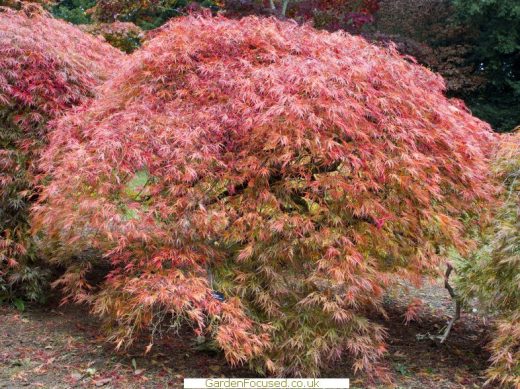GROWING JAPANESE MAPLES IN THE UK
WHERE TO PLANT JAPANESE MAPLES
As a general rule, Japanese Maples which are green in the summer withstand a good amount of sun throughout the year. In sunnier areas of the UK they should be in semi-shade for part of the afternoon. This will reduce the possibility of leaf burn. In areas with less natural sun they are best in full sun for the whole day, indeed they need the autumn sun in cooler areas if they are to turn orange / red / yellow in the autumn.
Other Japanese Maples which are variegated or naturally red all year should be grown in semi-shade. The shade should ideally be provided at the hottest part of the day. But don’t grow in all-day shade because even red / variegated varieties require a good amount of sun in order to develop their full autumn colour.
Article and pictures by David Marks.
BEST SOIL CONDITIONS FOR JAPANESE MAPLES
The roots of Japanese Maples are very fibrous unlike many other trees. This enables them to absorb higher than normal amounts of nutrients from the soil. This is the clue to ideal soil conditions for Japanese Maple trees. They prefer a slightly acidic soil which is well drained but not dry. Unusually, they do best on soils with a slightly lower than average amount of organic matter.
WHEN AND HOW TO WATER JAPANESE MAPLES
For the first two years hand watering may be required if the conditions are dry. Thereafter an annual mulch around the base of the tree in late spring is all that is needed.
Once the tree is established the key requirement is that the amount of water available should remain even. Where Japanese Maple trees are grown in areas short of water they will cope quite well, simply growing into a more shrubby tree compared to normal. The biggest danger comes where Japanese Maples are grown in places where the supply of water is variable. A relatively short, very dry and hot period will cause significant and sometimes total leaf drop. In these conditions water regularly as soon as the hot weather begins.
To summarise, the amount of water is not usually a problem for Japanese Maples but they definitely suffer where the amount of water available varies significantly especially when combined with changes in temperature.
WHEN AND HOW TO FEED JAPANESE MAPLE TREES
In most conditions Japanese Maples do not require feeding. If other shrubs grow well in that are then so will Japanese Maples. If the soil is very poor apply a general shrub fertiliser in mid Spring.
A definite rule is never to feed any Japanese Maples from early to mid-summer onwards, especially avoid nitrogen rich feeds. If you do feed after this time any new growth will be soft and much more liable to frost and wind damage in the winter.
HOW AND WHEN TO PRUNE JAPANESE MAPLES
Many people are afraid of pruning their Japanese Maples and the result is often a tree which grows too large for the available space. The key to pruning is to do it annually which will keep the tree to the required shape and size without the need for drastic infrequent pruning.
The time for pruning is also key. Only prune after leaf fall and always before the sap starts to rise early in the year. Late November to very early January is the best time in UK weather conditions. Don’t paint over the wounds, leave them to dry off naturally and quickly. A sharp and clean pair of secateurs is the ideal tool. Blunt tools squash and bruise the wood whilst dirty secateurs can easily spread infection.
Many Japanese Maple trees (dissectums particularly) tend to accumulate lots of twig like growth towards the centre of the tree. When the leaves open this growth tends to stop wind movement within the tree and encourages pests and diseases. So prune away some of this twiggy growth in winter for a healthier tree next year.
